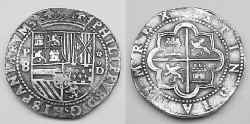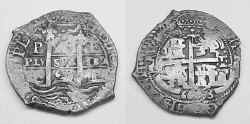|
Spanish
Colonial Silver Reales Coin Types Throughout the year we are frequently asked to help in
the identification of old coins presumed to be of Spanish origin.
Since Spanish colonial mints existed in the New World long before those of
the United States, their currency was an accepted standard and freely passed hands
in the American colonies. Thus, it is not unreasonable to assume
that a coin excavated on American soil or recovered from our surrounding
waterways to be of Spanish origin. Twelve Spanish colonial mints,
Mexico, Santo Domingo, Lima,
La Plata, Potosi, Panama,
Cartegena, Bogotá, Cuzco,
Guatemala, Santiago, and Popayan
produced a total of five
different types of silver reales coins, pillar,
shield, pillar
and waves, milled pillar, and milled
bust during Spain's almost 300 years of colonial rule. The information
provided should help in the identification of Spanish colonial
silver reales coins by coin type, time period, and mint of manufacture. Coin Types
(Click on pictures to enlarge)  Pillar
Type: The very first Spanish colonial silver coin design
in the New World. Struck at the Mexico, Santo Domingo, and Lima mints in the
time period of 1536 to 1572 - all undated. Pillar
Type: The very first Spanish colonial silver coin design
in the New World. Struck at the Mexico, Santo Domingo, and Lima mints in the
time period of 1536 to 1572 - all undated.
Design
Characteristics: Hand struck cob typically on a round full-sized
planchet. One side has a pair of pillars with or without waves
depending on the time period. The other side displays a simple
shield with lions and castles in the four quadrants and with a pomegranate
wedged in at the very bottom. Click here to
view
pillar type cobs offered for sale.  Shield
Type: The second type of Spanish colonial silver coin
design in the New World. Struck at the Mexico, Santo Domingo, Lima, La
Plata, Potosi, Panama, Cartagena, and Bogotá mints in the
time period of 1572 to 1734. Dates first appeared in 1607 at the
Mexico mint. Shield
Type: The second type of Spanish colonial silver coin
design in the New World. Struck at the Mexico, Santo Domingo, Lima, La
Plata, Potosi, Panama, Cartagena, and Bogotá mints in the
time period of 1572 to 1734. Dates first appeared in 1607 at the
Mexico mint.
Design Characteristics: Hand
struck cob, typically degrading in quality throughout the period.
One side has a crowned multi-element shield representing the lands under
Spanish control. The other side displays a cross with lions and
castles in the four quadrants. Visit
Atocha Coin Design for more
information. Click here to
view shield type cobs
offered for sale.  Pillars
and Waves Type: The third type of Spanish colonial silver
coin design in the New World. Struck at the Bogotá, Potosi,
Cartagena, and Lima mints in the time period of 1651 to 1773
- all with dates. Pillars
and Waves Type: The third type of Spanish colonial silver
coin design in the New World. Struck at the Bogotá, Potosi,
Cartagena, and Lima mints in the time period of 1651 to 1773
- all with dates.
Design Characteristics: Hand
struck cob, typically degrading in quality throughout the time period much
like it's predecessor. One side has a pair of pillars with waves and
two horizontal lines forming a tic-tac-toe design. The other side
displays a cross with lions and castles in the four quadrants. Click
here to view pillar and waves type cobs offered for
sale. The
coins of Bogotá and Cartagena along with the transition coins of Potosi
are slightly different in design, lacking the two horizontal lines forming
the tic-tac-toe on the first side and incorporating a simple shield with
lions and castles in the four quadrants in place of the cross on the
other, as in the earlier pillar type. Lima coins of
1659 and 1660 also lacked the two horizontal lines forming the tic-tac-toe
on the first side, but did not change from the cross design on the other.  Milled
Pillar Type: The fourth type of Spanish colonial silver
coin design in the New World. Struck at the Mexico, Santiago (very
rare), Lima, Guatemala, Bogotá (very rare) and Potosi mints
in the time period of 1732 to 1772 - all with dates. Milled
Pillar Type: The fourth type of Spanish colonial silver
coin design in the New World. Struck at the Mexico, Santiago (very
rare), Lima, Guatemala, Bogotá (very rare) and Potosi mints
in the time period of 1732 to 1772 - all with dates.
Design
Characteristics: Machine struck on a full-sized round
planchet. One side has a pair of pillars with waves separated by two
overlapping globes crowned with a single crown. The other side
displays a simple crowned shield with the typical lions, castles, and
pomegranate but also with the centralized addition of three Fleurs-de-Lis.
Click here to view milled pillar type coins
offered for sale. Guatemala
coins struck between 1733 and 1753 were irregular in shape and thus
considered to be cobs.  Milled
Bust Type: The fifth and final type of Spanish colonial
silver coin design in the New World. Struck at the Mexico, Lima, Bogotá,
Guatemala, Potosi, Santiago, Popayan, and Cuzco mints
in the time period of 1771 to 1825 - all with dates. Milled
Bust Type: The fifth and final type of Spanish colonial
silver coin design in the New World. Struck at the Mexico, Lima, Bogotá,
Guatemala, Potosi, Santiago, Popayan, and Cuzco mints
in the time period of 1771 to 1825 - all with dates.
Design
Characteristics: Machine struck on a round full-sized
planchet. One side displays the bust of the King, the other side a
pair of pillars separated by a crowned simple shield with lions, castles,
pomegranate and the centralized three Fleurs-de-Lis. Click here to
view
milled bust type coins offered for sale. Spanish Colonial Mints Listed
by order in which they opened.
| Mexico (1536-1821) |
Mintmark-M or M with small o above.
The mint produced the following coin types: Pillar type cob - (1536-1572),
shield type cob - (1572-1733), milled pillar - (1732-1771), and
milled bust - (1771-1821).
Also produced an irregular shaped machine struck shield type coin
(1733-1734)
Mexico never produced the pillars and waves coin design.
The first dated coin was struck in 1607.
|
Santo
Domingo(1542-1564)
(1573-1578) |
Mintmark-SP or monogram s
overlapping the left side of a large D with a small o above.
The mint produced the following coins types: Pillar type cob -
(1542-1564) rare,
shield type cob - (1573-1578) very rare.
Since the mint closed in 1578, none of the later coin types or
dated coins were ever produced.
|
| Lima (1568-1572)
(1577-1588)
(1659-1660)
(1684-1824) |
Mintmark-P, or P with star above,
or L, or LM, or LIMA, or a slightly overlapped ME. Lima has the distinction
of being the only mint to strike all five of the coin types.
Pillar type cob - (1568-1571),
shield type cob - (1572 and 1577-1588), pillars and waves type cob
- (1659-1660 and 1684-1752), milled pillar - (1752-1772), and
milled bust - (1772-1824).
The first dated coin was struck in 1659.
|
| La Plata (1573-1574) |
Mintmark-P. The mint was in
operation for a few short months and produced only shield type
cobs, which are indistinguishable from those of early Potosi
No dated coins were produced.
|
| Potosi (1574-1825) |
Mintmark-P or later a monogram PTSI
which looks similar to a dollar sign ($). The mint opened
after the pillar type cob period, thus it is the only coin type
not to see production. Shield type cob - (1574-1652),
pillars and waves type cob - (1652-1773), milled pillar -
(1767-1770), and milled bust - (1773-1825).
The first dated coin was struck in 1617.
|
| Panama (1580-1582) |
Mintmark-AP arranged
vertically. The mint was in operation for only a couple of
years and produced a limited number of undated shield type cobs -
all very rare.
|
| Cartagena (1622-1655) |
Mintmark-S, or RN arranged
vertically, or NR arranged vertically, or C. The mint
produced the following coin types: Shield type cob - (1622-1635)
rare and pillars and waves cob - (1653-1655) also rare.
The first dated coin was struck at the mint opening in 1622.The Cartegena mint is known more for its gold escudos coin
production.
|
| Bogotá (1622-1820) |
Mintmark-S, or NR both vertically
or horizontally, or NR with a small o above each arranged both
vertically or horizontally, or NR alone or with a single small o
above, or N, or SF or FS both vertically or horizontally, or
F. The mint produced the following coins types: Shield type cob -
(1622-1651) rare, pillars and waves cob - (1651-1748) rare, milled pillar -
(1759-1762) very rare, and
milled bust - (1772-1820) also rare.
The first dated coin was struck at the mint opening in 1622.The Bogotá mint is known more for its gold escudos coin
production.
|
| Cuzco (1698)
(1824) |
Mintmark-C or
CUZ. The mint
produced only one type of silver coinage, that being the dated
milled bust type in 1824 which incorporated the mintmark CUZ. Only gold 1 and 2 escudos were minted in 1698 using the
pillars and waves design and the mintmark C.
|
| Guatemala (1733-1821) |
Mintmark-G or NG. The mint
opened in 1733 when the first machine struck coins were being
introduced to the colonies. The mint produced a hand cut
pillar type coin (1733-1753) very similar to the later milled
pillar coin but irregular in shape like a conventional cob. Minted
next was the milled pillar - (1754-1771) followed by the milled
bust - (1773-1817).
|
| Santiago (1749-1817) |
Mintmark-S with a small o
above. The mint produced two types of coins, a very rare milled pillar -
(1751-1770) and a more common milled bust - (1771-1821). The Santiago mint is known more for its gold escudos coin
production.
|
| Popayan (1758-1822) |
Mintmark-P. The mint produced
only one type of silver coinage, the rare milled bust -
(1810-1822). The Popayan mint is known more for its gold escudos coin
production.
|
|




